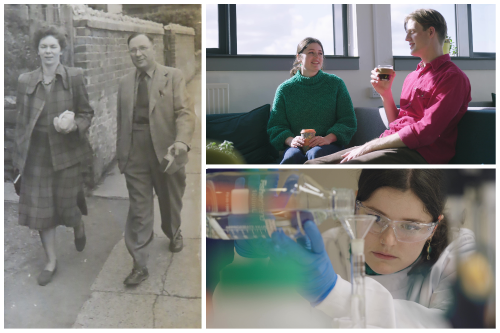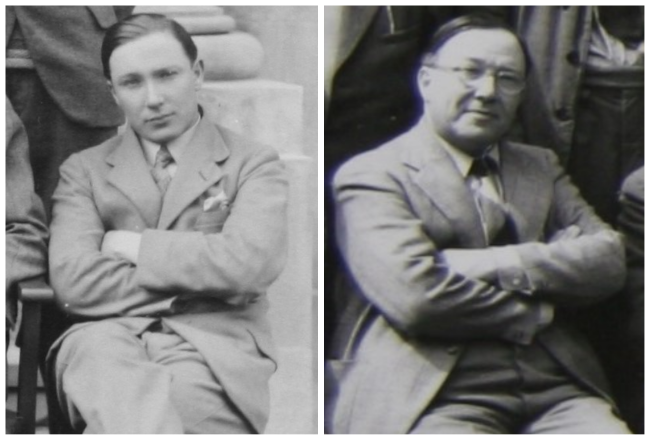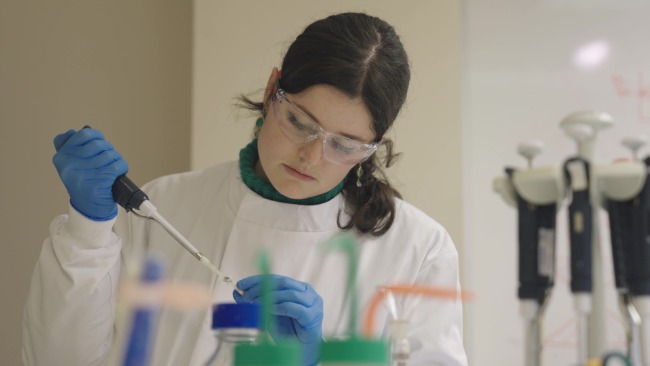
Bunty and HH Potter walking; Ellen Carrick and Edward Deacon; Ellen Carrick in the lab
A West Country family will fund a new generation of gifted physicists, after leaving the University of Bristol nearly £8million in their wills.
The HH Potter Fund is the largest gift ever left to the University. It will help fund six new physics PhDs every year for the rest of time; bolstering the University's already respected School of Physics.
The £7.7million was left by three siblings: Doreen (known to all as Bunty), Nigel and Leon Cobb, who grew up in Wick, to the east of Bristol.
The fund is named after Bunty's husband Harold Potter, who grew up in Bristol, joined the University aged 16 and went on to make discoveries that still resonate today.
Hugh Brady, Vice-Chancellor and President of the University of Bristol, said: "This incredible kindness will not just open up research positions to hundreds of gifted physicists but will also broaden our whole understanding of physics.
"PhD students are an indispensable part of any university. They break new ground, court new ideas and make discoveries that change the world."
Bunty and Harold met while working with a team of student and staff fire watchers during Nazi bombing raids in the Second World War.
At the top of the University's physics building – Potter's workplace and the highest point in the city – the brave pair alerted firefighters to where incendiary bombs fell across their city.
They married in 1950 and Potter struck up a lifelong friendship with Bunty's two younger brothers, Nigel and Leon, inspiring them to come to the University with regular lectures at their school.
Nigel would study medicine before a distinguished career as an orthopaedic surgeon. In 1982 he gained fame for spending nine weeks rebuilding Barry Sheene's legs, after the world champion motorcyclist crashed at Silverstone. Many thought he would never walk again.

- HH Potter during University of Bristol deparmental photos in 1928 and 1954
Leon studied veterinary science and became an eminent researcher at the University of Toronto and latterly the Medical Research Council in Didcot.
Harold's family owned a boot making factory in Hanham, Bristol. He graduated with a first in 1919 and returned to Bristol to lecture in 1924.
His important discoveries included where the manganese atoms sit within the crystal structure of a particularly important class of magnetic materials.
Several of his contemporaries in the School of Physics, such as Sir Nevill Mott and Professor Cecil Powell, went on to win Nobel Prizes.
%20with%20Nobel%20prize%20winner%20Sir%20Nevill%20Mott_ccexpress.jpeg)
- HH Potter (right) with Nobel Prize winner Sir Nevill Mott
Sadly, Harold died in 1959 aged just 59. It was at this point that Bunty vowed to set up a fund in his memory.
Upon her passing in 2003 £175,000 was donated to the fund. Nigel and Leon added the rest upon their deaths in 2018 and 2020 respectively.
The University of Bristol will invest the money and use the interest accrued to help fund six physics PhD scholarships every year in perpetuity.
Stephen Dugdale, Professor of Physics at the University of Bristol, said: "What is so touching about this story is that a man, born in 1900, has inspired legacy gifts in his name that will support future generations of PhD students in perpetuity.
"PhD students are the lifeblood of the department. They push research boundaries and expand our knowledge of physics, just as Potter did himself."
The scholarships will allow students to pursue a range of PhDs, opening avenues of research that may currently lack funding.
The first HH Potter scholars will begin their PhDs in September.
Ellen Carrick, who is investigating soft matter for her PhD at the University of Bristol, said: "The HH Potter fund gives scholars the flexibility and the agency to do the research that really inspires them.
"It will be really exciting to see over the next hundred years what research materialises out of the fund the family have left."

- Ellen Carrick working in the lab
Edward Deacon, who is studying for a PhD in integrated quantum photonics at the University of Bristol, said: "The School of Physics is very fortunate to have this fund, as it simply enables more students to study at the University and become young researchers.
"This is something that will continue in perpetuity so many more students long after me will come and do research.
"That's good for those people, but also for the University in terms of its research and the wider scientific community and what it could mean to the world."
The University has 3,500 research students, many of whom are doing PhDs.






